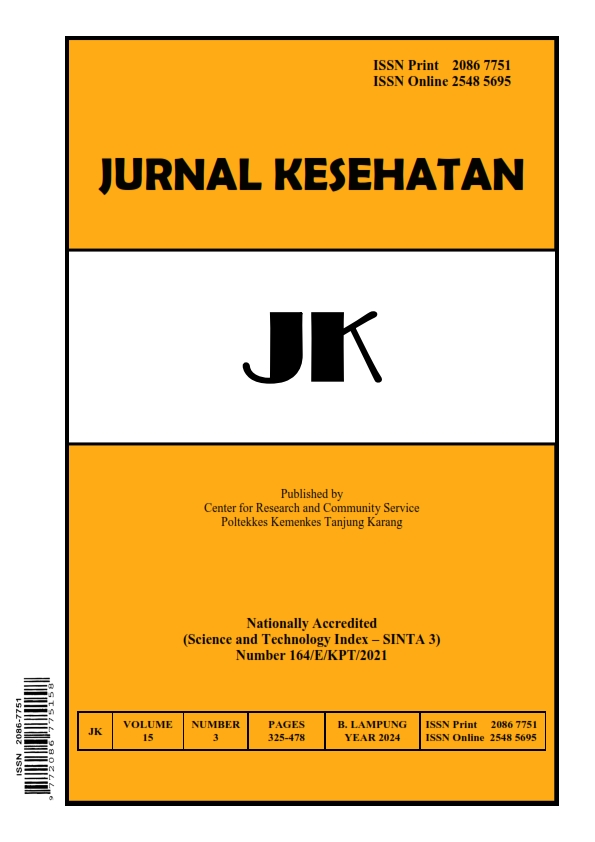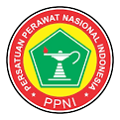The Impact of Child Injury Prevention Package (CIPP) on Injury Prevention in Toddler
DOI:
https://doi.org/10.26630/jk.v15i3.4743Keywords:
Children, Health promotion, Parents, PuskesmasAbstract
Injuries are a cause of morbidity and mortality in children under five. In Indonesia, the prevalence of injuries to children under five in 2013 was 8.5%, and in 2018, it was 8.2%. Injuries to toddlers derive from not-yet-optimal levels of development, high curiosity, lack of gross motor coordination, and the ability to anticipate danger. Nurses can provide anticipatory guidance to parents to increase parental understanding and prevent injuries to toddlers. The research aimed to determine the effect of CIPP on injury prevention in toddlers. The research method used the One group pre and post-test design with the population of all toddlers in the Puskesmas (Community Health Centre) Rajabasa Indah working area. The research sample using Proportional Random Sampling was 120 parents of toddlers. Data collection was done through interviews using screening cards. Data were analyzed using proportions and a T-test. The results of toddler characteristics were male (55.83%), toddler (55.83%), and standard nutritional status (70.8%). The proportion of toddlers who experienced injuries was 41.66%, and the most frequently experienced injuries were falls (37.5%). There was a significant difference in the mean value of knowledge about injury prevention in toddlers (p-value=0.000), environmental modification (p-value=0.000), and injury incidences in toddlers (p-value=0.000) before and after the anticipatory guidance intervention using CIPP. It is recommended to integrate CIPP into toddler health promotion, socialize CIPP with parents, cadres and kindergarten teachers, and develop CIPP-Android based applications.
References
Abbassinia, M., Barati, M., & Afshari, M. (2019). Effectiveness of interventions in the prevention of home injuries among children under 5 years of age: A systematic review. Archives of Trauma Research, 8(4), 190.
Arikunto, S. (2010). Prosedur Penelitian Suatu Pendekatan Praktik. Jakarta: Rineka Cipta
Asmarawanti, A., & Suhikmat, S. (2023). Tingkat Pengetahuan Ibu Tentang Resiko Kecelakaan Dengan Tindakan Pencegahan Kecelakaan Pada Balita Di Kelurahan Gunung Puyuh Kota Sukabumi Tahun 2022. HealthCare Nursing Journal, 5(1), 567-574. https://journal.umtas.ac.id/index.php/healtcare/article/view/2905
Banerjee, N., Sharma, N., Soni, K. D., Bansal, V., Mahajan, A., Khajanchi, M., Gerdin Wärnberg, M., & Roy, N. (2022). Are home environment injuries more fatal in children and the elderly? Injury, 53(6), 1987–1993. https://doi.org/10.1016/j.injury.2022.03.050
Bhatta, S., Mytton, J., & Deave, T. (2023). Home environmental change for child injury prevention in Nepal: A qualitative study. Journal of Child Health Care, 27(3), 323–335. https://doi.org/10.1177/13674935211052156
Davoudi-Kiakalayeh, A., Mohammadi, R., Pourfathollah, A. A., Siery, Z., & Davoudi-Kiakalayeh, S. (2017). Alloimmunization in thalassemia patients: New insight for healthcare. International Journal of Preventive Medicine, 8. https://doi.org/10.4103/ijpvm.IJPVM
Flavin, M. P., Dostaler, S. M., Simpson, K., Brison, R. J., & Pickett, W. (2006). Stages of development and injury patterns in the early years: A population-based analysis. BMC Public Health, 6. https://doi.org/10.1186/1471-2458-6-187
Gadsden, V. L., Ford, M., & Breiner, H. (2016). Parenting Matters: Supporting Parents of Children Ages 0-8. United States of America: National Academies Press. https://doi.org/10.17226/21868.
Hastuti, D. (2017). Hubungan pengetahuan tentang antisipasi cedera dengan praktik pencegahan cedera pada anak usia toddler di rw 01 kelurahan Manggahang wilayah Puskesmas jelekong kabupaten bandung. Jurnal Keperawatan Komprehensif (Comprehensive Nursing Journal), 3(1), 52-62. https://doi.org/10.33755/jkk.v3i1.85
Hastuti, R. P., & Musiana, M. (2024). The Factors Associated with Injury Risk in Toddlers. Malaysian Journal of Medicine and Health Sciences, 20(6), 47–52. https://doi.org/10.47836/mjmhs.20.s9.8
Hockenberry, Wilson, R. (2016). Wongs Essentials of Pediatric Nursing (tenth). Elsevier.
Jones, S., Tyson, S., Yorke, J., & Davis, N. (2021). The impact of injury : The experiences of children and families after a child's traumatic injury. https://doi.org/10.1177/0269215520975127
Louise, M. (2020). Australia’s children. Australian Institute of Health and Welfare, 14 ( 3).
Ministry of Health Republic Indonesia. (2018). Laporan Riset Kesehatan Daerah 2018. Jakarta.
Mirahmadizadeh, A., Hemmati, A., Zahmatkesh, S., Saffari, M., & Bagheri, P. (2020). Incidence of accidents and injuries in children under 6 years old in southern Iran: a population-based study. Journal of injury and violence research, 12(2), 135. https://doi.org/10.5249/jivr.vo112i2.1280
Schnitzer, P. G. (2013). Prevention of unintentional childhood injury. American Family Physician, 87(7), 502–509.
Stewart, T. C., Clark, A., Gilliland, J., Miller, M. R., Edwards, J., Haidar, T., Batey, B., Vogt, K. N., Parry, N. G., Fraser, D. D., & Merritt, N. (2016). Home safe home: Evaluation of a childhood home safety program. Journal of Trauma and Acute Care Surgery, 81(3), 533–540. https://doi.org/10.1097/TA.0000000000001148
Tsitsimpikou, C., Georgiadis, N., Tsarouhas, K., Kartsidis, P., Foufa, E., Bacopoulou, F., Choursalas, A., Kouretas, D., Nikolaidis, A. K., & Koulaouzidou, E. A. (2021). Children and parents’ awareness regarding potential hazards derived from the use of chemical products in Greece. International Journal of Environmental Research and Public Health, 18(24). https://doi.org/10.3390/ijerph182412948
WHO. (2014). World Report on Child Injury Prevention. Switzerland: WHO Press.
Words, K. E. Y. (2020). Incidence of accidents and injuries in children under 6 years old in southern Iran: a population-based study. 12(2), 135–144.
Downloads
Published
Issue
Section
License
Copyright (c) 2024 Retno Puji Hastuti, Musiana Musiana

This work is licensed under a Creative Commons Attribution-ShareAlike 4.0 International License.
Authors who publish in this journal agree to the following terms:
- Authors retain copyright and grant the journal right of first publication with the work simultaneously licensed under a Creative Commons Attribution License (CC BY-SA 4.0) that allows others to share the work with an acknowledgment of the work's authorship and initial publication in this journal.
- Authors can enter into separate, additional contractual arrangements for the non-exclusive distribution of the journal's published version of the work (e.g., post it to an institutional repository or publish it in a book), with an acknowledgment of its initial publication in this journal.
- Authors are permitted and encouraged to post their work online (e.g., in institutional repositories or on their website) prior to and during the submission process, as this can lead to productive exchanges and earlier and greater citations of published work.












